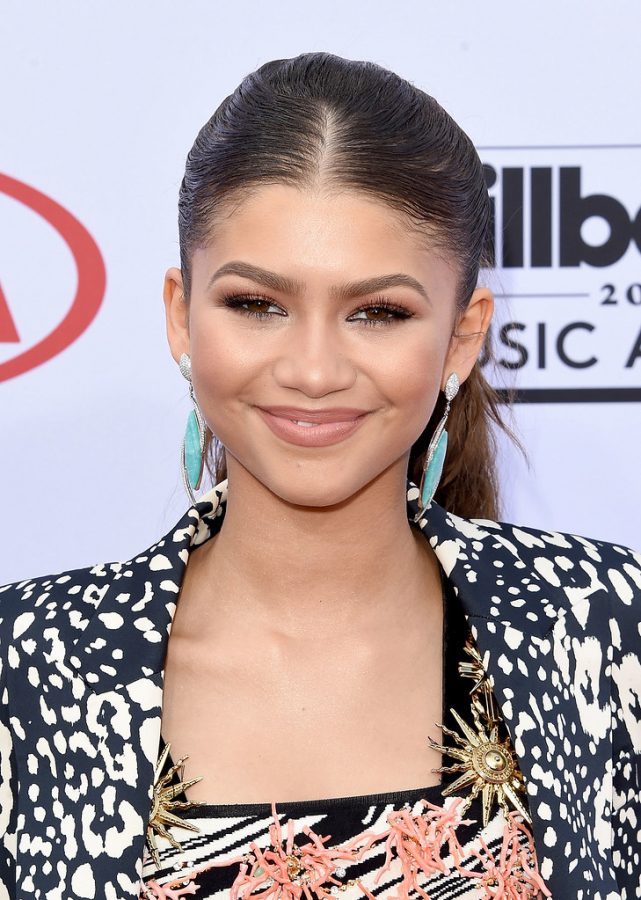How ‘Euphoria’ comments on Generation Z and society today
Courtesy of Creative Commons “139579_3454” by Walt Disney Television is licensed under CC BY-ND 2.0
Featured is a picture of Zendaya, the omniscient narrator and one of the seven main characters, in “Euphoria”.
August 7, 2020
Last Tuesday, July 28, HBO’s “Euphoria,” was nominated for six Emmy Awards, exciting its fanbase attracted to the eloquence and haunting charm of its social commentary.
The title itself is ironic because the work teasingly dangles a sense of euphoria before the audience. The series’ brilliantly lit visuals illuminate the perversity of events instead of conveying joyfulness. For proof, one may look to the clarity and softness of a scene in which, against faint moonlight, Rue Bennett (played by Zendaya) nurses the self-harm wounds of her best friend Jules Vaughn (Hunter Schafer).
Such intentionally clashing aesthetics complement the show’s soundtrack, a din of contradictory notes of both youthful curiosity and dismal introspection.
Unlike most shows, “Euphoria” has seven main characters, none of whom appear to have a protagonistic role. This intertwined group suffers from a plethora of social issues in order to dismantle popular, idealistic visions about growing up in the U.S.
Six of the main characters attend East Highland High School, located near Los Angeles, and the seventh, Christopher McKay (played by Algee Smith), attends a nearby college to play football.
Each character comes from a place of brokenness and seeks empowerment through an escapist journey. These searches ultimately end in vulnerability and disempowerment, which imply that preexisting support infrastructures and cultural dogmas fall short in aiding American youth.
National politics are also sometimes evoked throughout the story. Rue, after all, was born on Sept. 11, 2001 and witnesses the attacks on the World Trade Center from behind a TV monitor in her hospital delivery room, demonstrating that Generation Z was born into a world of multifaceted, deeply rooted chaos. Thus, Rue doubts and distrusts the world and lives by ideas gleaned from her own and her friends’ experiences, including the objectification of women.
Set in 2019, the series also shows how U.S. political governance has set poor behavioral examples for children, as several national incumbents throughout that year were nakedly unethical, failing to focus on cooperation.
American individualism and shame directed towards sexual pleasure constitute further examples of negative social pressures, yet perpetuation of such attitudes is ascribed both to Generation Z and to parent generations.
Evidence of both in “Euphoria” lies most obviously with Kat Hernandez (played by Barbie Ferreria), an unpopular “smut” fanfiction writer who struggles with self-perceived ugliness and obesity. She initially reaps robust rewards from camgirling, a type of virtual sex work, but in the absence of guidance is eventually pressured to perform uncomfortable acts by a wealthy client. She also begins doing sex work for older men at 16 as a child, indicating that her endeavor is fairly exploitative even when Kat seems to be in charge of her sexual capital.
While the outside world and societal standards have taken a toll on characters’ lives, some blame is still placed on each individual. Rue, for one, screams at and physically threatens her prying, concerned mother, ultimately damaging their relationship, and McKay coerces Cassie (Sydney Sweeney) into sex as self-compensation for a fraternity sexual assault disguised as hazing.
The connections between the seven main characters are not only apparent through their bonds, as all of the character storylines bear underlying parallels. Whether through friend groups or observation from afar, each of the main characters possesses some degree of insight into the lives of the other six.
There are clear examples of indirect connections through discrete social circles and the spread of rumors regarding partner abuse, sex and more.
In fact, Rue appears to know the internal and external life of each of the main characters while maintaining a close relationship only with Jules. Her character ultimately exemplifies young people’s tendency to remain divided along the lines of different, arbitrary groups, even when in close physical and social proximity to each other.
All of this suggests that the show is a catalyst for debate on societal issues and the complex lives of Generation Z. Audience members are not urged to side with one character over another, since they are all interconnected and deeply flawed. There is, in the end, no protagonist.
Unity and empathy could solve the sharp divides that plague East Highland. Thus, the objective of “Euphoria”, in the end, is the illumination of the suffering of modern youth and how unification and understanding can become the ultimate antidote to myriad social issues.







